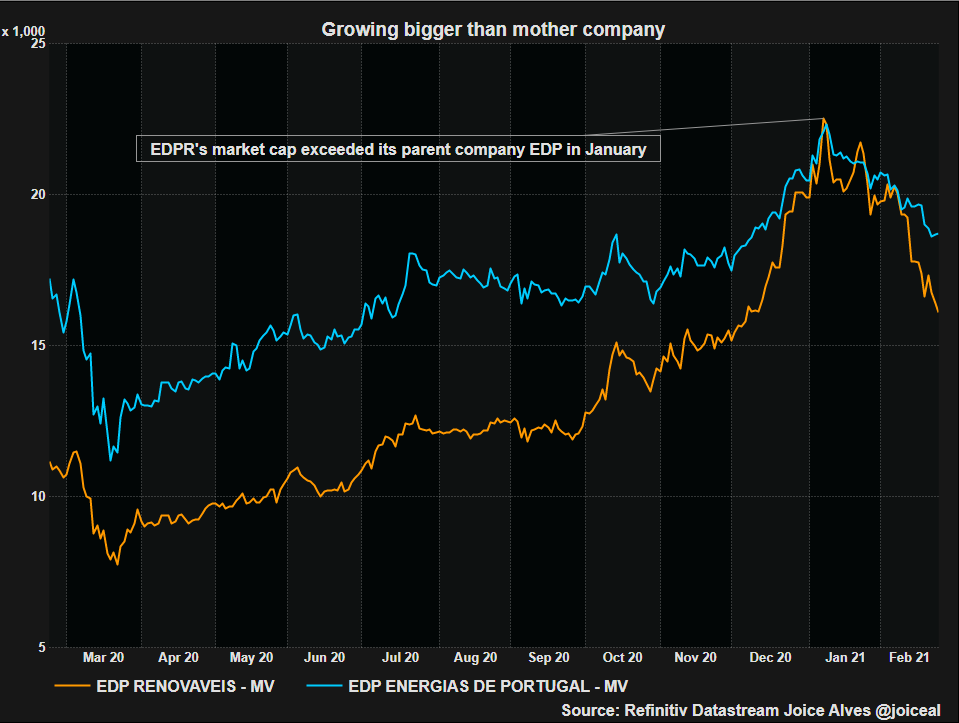LONDON – The booming market in green finance faces a test this year as more investors balk at lofty share price tags even on loss-making companies and a gradual economic recovery from the pandemic boosts returns on conventional energy assets.

Source: Reuters
Driven by government promises to deliver a low carbon recovery, flows into funds investing on environmental, social and corporate governance (ESG) principles doubled last year from 2019 to $326 billion, Morningstar data showed.
But that has also made ESG one of the most crowded trades, BofA’s latest investor survey released on Tuesday found, while the supply of green securities has failed to keep pace with demand.
Emmanuel Cau, head of European equity strategy at Barclays, has warned of a “regime change” if the cycle were to turn in favour of value sectors, which benefit from economic recovery, and away from high-quality, high-value assets that are more sensitive to higher bond yields.
Cau last year cut his overweight recommendation on ESG utilities and last month upgraded conventional energy stocks to overweight, citing depressed investor positioning and the sector’s ability to capitalise on a post-pandemic recovery.
While most investors see the green investing trend as here to stay, they have grown wary after the huge price run-up.
“Valuations in the (green) sector are significantly higher than what we want to pay so we won’t allocate as much as we’d like to,” Justin Onuekwusi, fund manager at Legal & General Investment Management, said.
Supply of clean energy assets, meanwhile, shows signs of becoming less tight.
Refinitiv data indicates equity raising by sustainable companies totalled $6.6 billion year-to-date, a 28% increase on year-ago levels, although it is still only 2.5% of total activity.
In the green bond market too, there are hints of a strong increase in supply this year after last year’s scarcity brought into focus the so-called greenium – the extra premium investors have to pay to secure a green bond.
Following last year’s heavily oversubscribed green bond issues, Nordic bank SEB predicts green bond sales will double this year to $500 billion. France tapped green markets on Tuesday, while the European Union and Britain are prepping deals.
Cumulative green bond issuance, used for funding projects such as clean energy, surpassed $1 trillion in December, according to the Climate Bonds Initiative, though Spain’s BBVA estimates this is under 1% of the global bond market.
Such has been the supply-demand imbalance that the market value of renewables developer EDPR rose in January above that of its parent EDP.
The picture, says NN Investment Partners senior portfolio manager Oskar Tijs, is best described as euphoria.
“Companies, which in many cases have been lagging for years because their earnings were low or negative, have performed… Money flows have been so strong that in some cases, you can question if it is still reasonable,” Tijs said.
HARD TO SUSTAIN
At the height of the pandemic last year, more than 80% of sustainable equity indices outperformed non-ESG peers, the Institute of International Finance estimates.
Rising prices led one-year forward price-earnings multiples on a basket of 35 green stocks to expand by 24 points in the last year, analysis by Morgan Stanley found. Multiples at non-green peers expanded by two points.
Yet Refinitiv IBES data going back to 2016 shows two of last year’s top performing green stocks – fuel cell makers Plug Power and FuelCell Energy – have never turned a profit and are not expected to do so for years.
Carmaker Tesla enjoyed its first profit in 2020 and solar firm Enphase has been profitable for two years.
Yet these shares have rallied between 400% and 1000% in the past year.
Sharon Bentley-Hamlyn, investment director at Aubrey Capital Management, has 2%-3% of her portfolio in green energy.
“We’d love to have more but it’s difficult to find stocks that meet valuation criteria. We like to buy at 1.5-times PEG ratio or less but many of them are trading near 2-times,” she said, referring to the metric measuring share price, earnings and future growth prospects.
“You don’t want to bet the ranch on these types of businesses which are still loss-making.”
Graphic: EDPR’s market cap exceeds its parent company –
THE CRAZY GREENIUM
Investors often have to pay extra for green bonds, especially in sectors in which such issues are scarce and this greenium applies even when a green bond has a longer maturity than mainstream issues.
Dutch mail carrier PostNL’s 2026 green bond offers 41 basis points over swaps – a measure of a bond’s credit risk – 5 bps less than a mainstream bond maturing two years earlier..
Daimler’s 2030 green issue pays 10 bps below a conventional bond due earlier that year.
“This is crazy. You move along the curve, you take more risk, you get paid less,” said Shanawaz Bhimji, senior fixed income strategist at ABN AMRO.
Green issuers in the euro investment-grade market last year conceded an average 8 bps “new issue premium,” ABN AMRO estimates, less than half that paid across the broader market.
And investor demand exceeded issuance 5.5 times on average in 2020, versus four times on non-green bonds, ABN said.
Graphic: Cheaper for companies to issue green bonds –
For all the mounting caution, James Palmer, BofA’s head of EMEA equity capital markets sees supply-demand mismatches supporting prices for a while yet.
He is busy discussing with companies that own sustainable businesses “whether they can and should separate them to get the valuations that the market is prepared to afford”.



